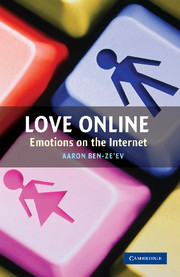Book contents
- Frontmatter
- Contents
- Preface
- 1 The seductive space
- 2 The paradoxical nature of online relationships
- 3 Emotions on the Net
- 4 Online imagination
- 5 Online privacy and emotional closeness
- 6 Is it worth it?
- 7 Flirting on- and offline
- 8 Cyberlove
- 9 Chatting is sometimes cheating
- 10 The future of romantic relationships
- Notes
- Bibliography
- Index
5 - Online privacy and emotional closeness
Published online by Cambridge University Press: 22 September 2009
- Frontmatter
- Contents
- Preface
- 1 The seductive space
- 2 The paradoxical nature of online relationships
- 3 Emotions on the Net
- 4 Online imagination
- 5 Online privacy and emotional closeness
- 6 Is it worth it?
- 7 Flirting on- and offline
- 8 Cyberlove
- 9 Chatting is sometimes cheating
- 10 The future of romantic relationships
- Notes
- Bibliography
- Index
Summary
It's so simple to be wise. Just think of something stupid to say and then don't say it.
Sam LevensonPrivacy is characterized as the right to be left alone, to be allowed to pursue one's activities without interference, scrutiny, or comment. Why is such a right important? Why do we want to be left alone without having the focus or attention of other people trained on us? The simple answer is that such scrutiny can harm us as it may conflict with some of the values that we or those close to us hold. However, while we wish to guard our privacy, we also want to be close and open with others by expressing our genuine emotional attitudes through which honesty is developed in a relationship. In personal relationships, privacy involves a process of boundary regulation, while openness implies boundary deregulation.
Emotions are typically associated with both closeness and openness. The desire for privacy seems to contradict these related features. Being emotionally close and open means losing some of our privacy, and maintaining a greater degree of privacy prevents us from being emotionally close and open.
The conflict between privacy and emotional closeness and openness is considerably weaker in cyberspace. The relative anonymity of cyberspace and the ability to control which matters we wish to reveal allow us to safeguard our privacy while increasing emotional closeness and openness.
- Type
- Chapter
- Information
- Love OnlineEmotions on the Internet, pp. 95 - 119Publisher: Cambridge University PressPrint publication year: 2004



